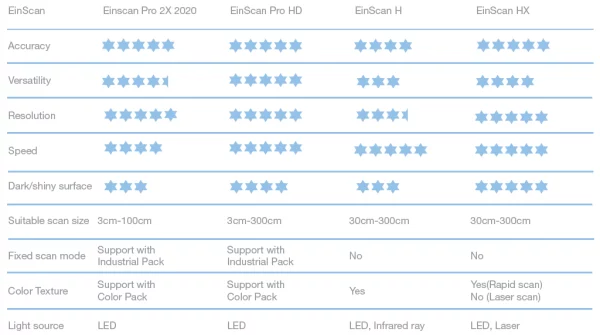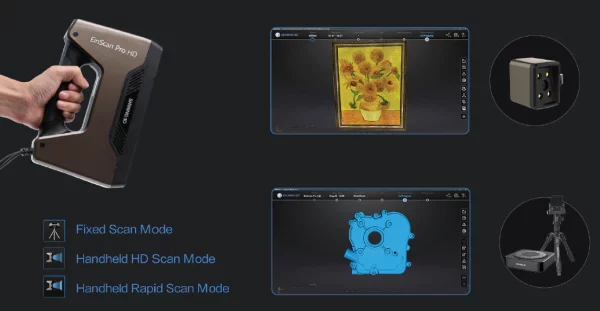BASICS ABOUT 3D SCANNING
3D scanners have become an essential tool to turn physical objects into 3D digital models compatible with CAD/CAM and other design softwares, 3D printing and digital manufacturing technologies. They are widely used in many industries, like medical health, inspection, reverse engineering, education, cultural & heritage preservation, and many more. When you google “3D scanner”, you will be surprised about the millions of results showing up. How to choose the right 3D scanner to meet your needs? Is the lowest price the best price? Is the expensive one the right one for you? You don´t want to miss to carefully evaluate all the product specifications and thoroughly compare the different models with each other. We have created this guidebook to share some key specifications helping
you to select the device that perfectly meets your need. Covering all the relevant aspects from accuracy, resolution, scan speed, scan size and light source, we hope that this guidebook will be a reliable companion for you on the journey to finding the 3D scanner suiting your requirements.
1. Laser Scanner or Structure Light Scanner
You can’t say that one system is better than the other system. Each system has its strengths and weaknesses.

Laser scanning works through projection of a laser point, beam or multi beams onto an object and then capturing the laser´s reflection with sensors.

Structure light scanners project a light pattern on the object to be scanned. These light patters are tracked simultaneously by one camera or multiple cameras. With a color camera, color capturing is available, too. The pattern of light is produced by using light modulators based on different technologies.
The main advantage of laser scanning is that it is less sensitive to environment light and performs better in scanning shiny or dark surfaces. And, most of the laser scanners are handheld. However, very shiny or transparent surfaces are also difficult to capture by laser scanning.
Projecting light pattern rather than a laser line, a structured light 3D scanner can capture a large size in seconds, and also guarantees a high level of accuracy and high resolution. The light source is not hazardous to the human eyesight, so structure light scanning technology can be used to scan people Structure light scanners can be tripod mounted for stational scanning, and also used in handheld mode to scan by going around the objects. However, it is sensitive to environment light conditions and reflective parts.
2. Resolution
Resolution is defi ning the point distance which the scanner is capturing. The distance between two points in a 3D model is one of the most important factors for your scan.
When you take a high resolution, the point distance is very small, and details are better to see on the scan. If you take a low resolution the point distance is big and big objects can be captured faster.

Using SHINING 3D´s handheld scanners, the resolution can be changed
depending on the object size.

3. Accuracy
The accuracy gives an information about the authenticity of a 3D model to the real object. Knowing the accuracy of your scanner is very important because it determines whether it is suitable for quality inspection, reverse engineering design, medical health, or any other applications with rigid accuracy requirements. Usually, the higher accuracy the scanner is able to generate, the more applications it could be suitable for, and of course, the higher the cost is. So, when you consider accuracy, you need to think about what you want to scan and if a high accuracy is absolutely necessary. Do you really need a very high accuracy?
The accuracy used in the specifications of the scanner usually refer to the accuracy of a single scan. The volumetric accuracy refers to the relationship between 3D data accuracy and object size; with EinScan Pro Series the accuracy is reduced by 0.3mm/m. This conclusion is obtained by measuring the center of sphere under marker alignment. The volumetric accuracy of EinScan HX in laser mode is 0.06 mm/m.
4. Scan Speed
Scan speed is a specification to define how long it takes to scan one given object. It especially matters when you are going to scan the human body, as people can not stay still for a long time, and it also helps to improve the work efficiency when you are going to scan big objects like cars, buildings, etc.
Scan speed can be expressed by points amount collected per second, frames per second, or how many seconds it takes to do a single scan. The more points or frames collected per second, the faster the scan speed.
EINSCAN MODEL SPECIFICATION

COMPARISON
1. Light Source Comparison

2. Accuracy Comparison
In general, there are not many differences between all EinScan series scanners mentioned above. EinScan Pro HD and EinScan Pro 2X 2020 both have the same accuracy of 0.045mm in Handheld HD mode, while it is 0.05mm for EinScan H in body and standard mode, and 0.04mm for EinScan HX in laser mode. So accuracy might not be a critical parameter for you to choose a proper device among EinScan series. If high accuracy is a top priority on your agenda, EinScan HX is the best choice among all EinScan scanners. Let´s explore more details on the next pages.
3. Resolution Comparison
Before making a conclusion, let’s check out below screenshots of data scanned in handheld HD mode respectively by EinScan Pro HD and EinScan Pro 2X 2020, and standard mode respectively by EinScan H and EinScan HX.
Judging from the comparison of data quality, we can easily know that EinScan Pro HD and EinScan Pro 2X 2020 do a better job in the fi ne detail capturing, due to their different projecting patterns in handheld HD mode.




In conclusion, if the best resolution is requested when scanning medium to large objects, either EinScan Pro HD or EinScan 2X 2020 could be your ideal companion. If the best resolution is requested when scanning small objects, EinScan Pro 2X 2020 is your best choice.
4. Speed Comparison
To compare the speed of scanners, two facts need to be considered: single scan range and the points captured per second. For points captured per second, in Handheld Rapid mode, all scanners of the EinScan Pro Series come with the same speed of 1,500,000 points/s.
However, regarding the single scan range, EinScan Pro HD is bigger than EinScan Pro 2X 2020, achieving a more fl uent scan to improve your working efficiency.
EinScan H(standard scan&body scan) and EinScan-HX(rapid scan) come with the same scan speed in terms of points captured per second and scan range, which are all faster than Pro series.
However, in the face scan mode of EinScan-H, the maximum scan range could reach 780mm*900mm


EINSCAN APPLICATION & SCANNER RECOMMENDATION

EinScan Pro 2X 2020
EinScan Pro 2X 2020 is a versatile handheld 3D scanner which can perform in both handheld and fi xed scan modes for high resolution results up to 0.16mm. A great option for scanning of small to medium size objects (3cm-100cm) and ideal for high-quality 3D modeling and design.


EinScan Pro HD
EinScan Pro HD delivers unparalleled performance in capturing high resolution and accuracy by handheld scanning. Exceptional versatility and powerful optimizations come together for the ultimate high-effi ciency and professional-grade 3D scanning experience.


By adopting a new structure light projection modular, the stripe pattern scanning which was traditionally used in Fixed Scan Mode is now utilized to Handheld HD Scan Mode. By 0.2mm minimum point distance setting with optimized algorithm, it brings high resolution and accuracy in handheld scanning as good as under fixed scan. Suitable to scan intricate carving and artworks with rich details.
With new lighting projection hardware and software algorithm, EinScan Pro HD is capable to scan a wider range of objects of dark or black color and casting metal surface, enriching the capability for 3D scanning of materials, suitable for car interior design and metal parts scanning.

EinScan H
The scan is fast without light perception. It captures more complete data including hair. Dedicated body mode and portrait mode facilitate and professionalize the scanning process.The portrait mode adopts infrared ray to reduce eye discomfort in the process of scanning and realize hair acquisition at the same time to acquire complete portrait data.
When scanning bodies, the new non-rigid algorithm in body mode facilitates data acquisition despite slight movements.


EinScan HX
By adopting laser light, EinScan HX manages to scan dark and black colored surfaces, as well as casted metal surfaces with less limitations. The extended scan range enables scanning of large objects at fast pace, suitable for applications like cars for modifi cation and customization, or big metal parts for reverse engineering. The LED light pattern makes fast scanning without previous preparation with reference points possible. Laser scanning guarantees outstanding accuracy and high resolution.
The fusion of two different types of light in one device facilitates scanning of different materials, in a broad field of applications for a large number of industry sectors.


